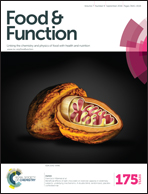A green tea-containing starch confection increases plasma catechins without protecting against postprandial impairments in vascular function in normoglycemic adults†‡
Abstract
Postprandial hyperglycemia (PPH) increases cardiovascular disease risk regardless of glucose intolerance by transiently impairing vascular endothelial function (VEF) by limiting nitric oxide bioavailability in an oxidative stress-dependent manner. Preclinical studies show that green tea catechins attenuate PPH by inhibiting starch digestion. We hypothesized that a starch-based confection containing catechin-rich green tea extract (GTE) would limit PPH-mediated impairments in VEF in normoglycemic adults. We formulated a unique GTE confection and then conducted a double-blind, randomized, controlled, crossover study in healthy men (n = 15; 25.3 ± 1.0 years; 22.4 ± 1.8 kg m−2) in which they ingested starch confections (50 g carbohydrate) formulated with or without GTE (1 g) prior to evaluating sensory characteristics of confections and plasma glucose, biomarkers of lipid peroxidation and nitric oxide homeostasis, and brachial artery flow-mediated dilation (FMD) at 30 min intervals for 3 h. Sensory evaluation of confections indicated acceptable consumer appeal and an inability to distinguish between confections regardless of GTE. Plasma catechins concentrations increased following ingestion of the GTE confection. However, plasma glucose peaked at 60 min (P < 0.05) following confection ingestion and was unaffected throughout the postprandial period by the GTE confection (P > 0.05). FMD was significantly decreased only at 60 min regardless of confections containing GTE. Also at 60 min, both confections similarly increased plasma malondialdehyde while decreasing arginine and increasing asymmetric dimethylarginine/arginine. The successfully formulated GTE-containing confection effectively delivered catechins, but without mitigating PPH-mediated impairments in VEF in association with oxidative stress that likely limits nitric oxide bioavailability.


 Please wait while we load your content...
Please wait while we load your content...